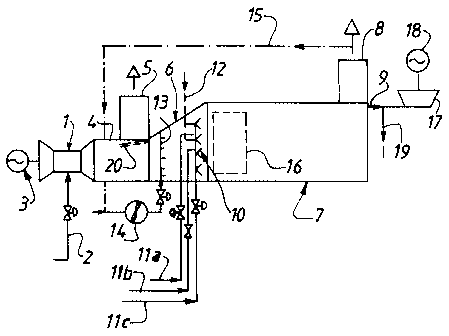Some of the information on this Web page has been provided by external sources. The Government of Canada is not responsible for the accuracy, reliability or currency of the information supplied by external sources. Users wishing to rely upon this information should consult directly with the source of the information. Content provided by external sources is not subject to official languages, privacy and accessibility requirements.
Any discrepancies in the text and image of the Claims and Abstract are due to differing posting times. Text of the Claims and Abstract are posted:
| (12) Patent: | (11) CA 2296879 |
|---|---|
| (54) English Title: | PROCESS FOR THE TREATMENT OF STEEL WORK GASES |
| (54) French Title: | PROCEDE DE TRAITEMENT DES GAZ D'ACIERIE |
| Status: | Expired and beyond the Period of Reversal |
| (51) International Patent Classification (IPC): |
|
|---|---|
| (72) Inventors : |
|
| (73) Owners : |
|
| (71) Applicants : |
|
| (74) Agent: | NORTON ROSE FULBRIGHT CANADA LLP/S.E.N.C.R.L., S.R.L. |
| (74) Associate agent: | |
| (45) Issued: | 2007-05-08 |
| (22) Filed Date: | 2000-01-24 |
| (41) Open to Public Inspection: | 2000-08-11 |
| Examination requested: | 2003-12-09 |
| Availability of licence: | N/A |
| Dedicated to the Public: | N/A |
| (25) Language of filing: | English |
| Patent Cooperation Treaty (PCT): | No |
|---|
| (30) Application Priority Data: | ||||||
|---|---|---|---|---|---|---|
|
Steel work gases (blast-furnace gases, coke--oven gases, converter gases, etc.) are burnt, optionally with a supply of natural gas (12) and of air (13), in a postcombustion section (6) between the outlet of a gas turbine (1) causing generation and the inlet of a recovery boiler (7), the steam from which is utilized especially for producing electrical energy. Application to the combustion of residual gases in steelmaking and to the production of energy.
Les gaz d'aciérie (gaz de hauts fourneaux, gaz de cokerie, etc.) sont brûlés, facultativement en ajoutant du gaz naturel (12) et de l'air (13), dans une section de postcombustion (6) entre la sortie de la turbine à gaz (1) causant la génération et l'entrée d'une chaudière de récupération (7), la vapeur ainsi produite étant utilisée pour la production d'électricité. Application à la combustion des gaz résiduels de la fabrication d'acier et de la production d'énergie.
Note: Claims are shown in the official language in which they were submitted.
Note: Descriptions are shown in the official language in which they were submitted.

2024-08-01:As part of the Next Generation Patents (NGP) transition, the Canadian Patents Database (CPD) now contains a more detailed Event History, which replicates the Event Log of our new back-office solution.
Please note that "Inactive:" events refers to events no longer in use in our new back-office solution.
For a clearer understanding of the status of the application/patent presented on this page, the site Disclaimer , as well as the definitions for Patent , Event History , Maintenance Fee and Payment History should be consulted.
| Description | Date |
|---|---|
| Time Limit for Reversal Expired | 2020-01-24 |
| Common Representative Appointed | 2019-10-30 |
| Common Representative Appointed | 2019-10-30 |
| Letter Sent | 2019-01-24 |
| Inactive: Correspondence - Transfer | 2008-11-14 |
| Letter Sent | 2008-04-29 |
| Letter Sent | 2008-04-29 |
| Letter Sent | 2008-04-29 |
| Letter Sent | 2008-04-29 |
| Grant by Issuance | 2007-05-08 |
| Inactive: Cover page published | 2007-05-07 |
| Pre-grant | 2007-02-20 |
| Inactive: Final fee received | 2007-02-20 |
| Notice of Allowance is Issued | 2006-10-31 |
| Letter Sent | 2006-10-31 |
| Notice of Allowance is Issued | 2006-10-31 |
| Inactive: Approved for allowance (AFA) | 2006-09-21 |
| Inactive: IPC from MCD | 2006-03-12 |
| Inactive: IPC from MCD | 2006-03-12 |
| Amendment Received - Voluntary Amendment | 2005-12-15 |
| Inactive: S.30(2) Rules - Examiner requisition | 2005-10-25 |
| Amendment Received - Voluntary Amendment | 2004-02-19 |
| Letter Sent | 2004-01-06 |
| Request for Examination Received | 2003-12-09 |
| Request for Examination Requirements Determined Compliant | 2003-12-09 |
| All Requirements for Examination Determined Compliant | 2003-12-09 |
| Letter Sent | 2002-05-09 |
| Application Published (Open to Public Inspection) | 2000-08-11 |
| Inactive: Cover page published | 2000-08-10 |
| Letter Sent | 2000-04-07 |
| Inactive: IPC assigned | 2000-03-15 |
| Inactive: First IPC assigned | 2000-03-15 |
| Inactive: IPC assigned | 2000-03-15 |
| Inactive: Single transfer | 2000-03-07 |
| Inactive: Courtesy letter - Evidence | 2000-02-29 |
| Inactive: Filing certificate - No RFE (English) | 2000-02-28 |
| Filing Requirements Determined Compliant | 2000-02-28 |
| Application Received - Regular National | 2000-02-24 |
There is no abandonment history.
The last payment was received on 2006-12-20
Note : If the full payment has not been received on or before the date indicated, a further fee may be required which may be one of the following
Please refer to the CIPO Patent Fees web page to see all current fee amounts.
Note: Records showing the ownership history in alphabetical order.
| Current Owners on Record |
|---|
| L'AIR LIQUIDE, SOCIETE ANONYME POUR L'ETUDE ET L'EXPLOITATION DES PROCEDES GEORGES CLAUDE |
| Past Owners on Record |
|---|
| EMMANUEL POUSSET |
| GENEVIEVE MURE |
| JEROME GIRARD |
| PASCAL AVART |